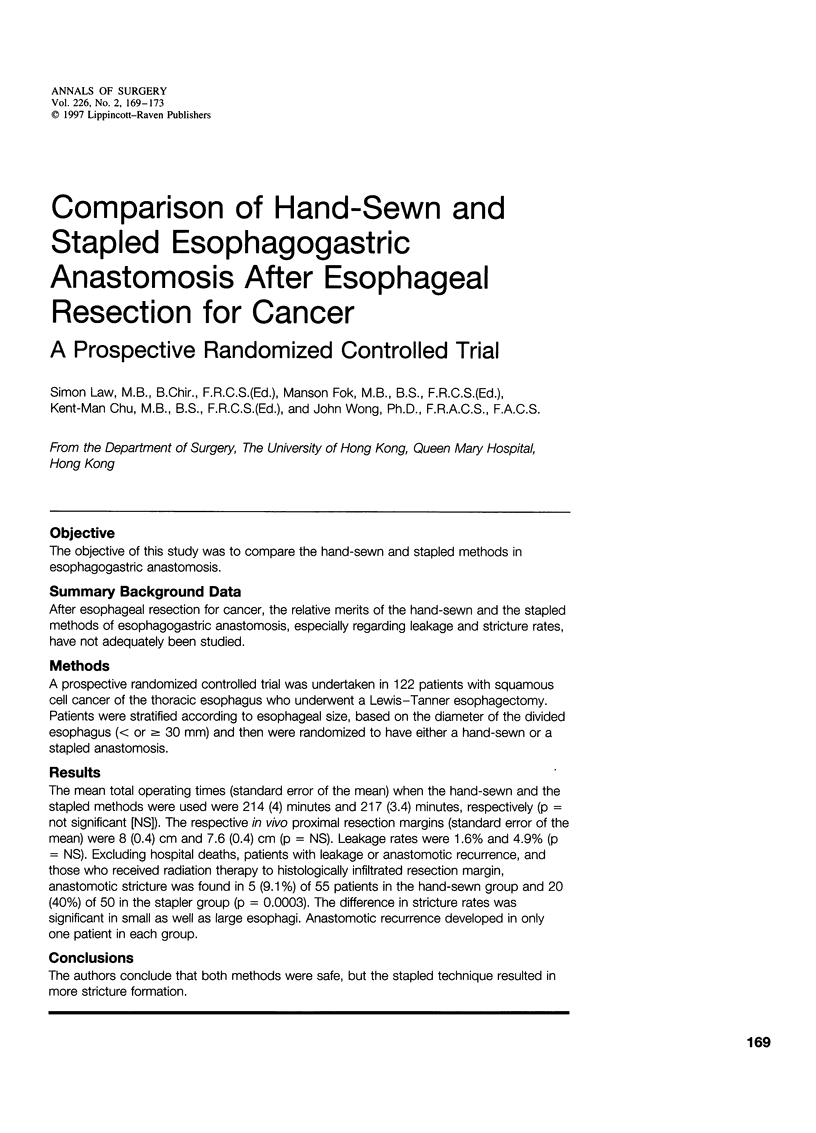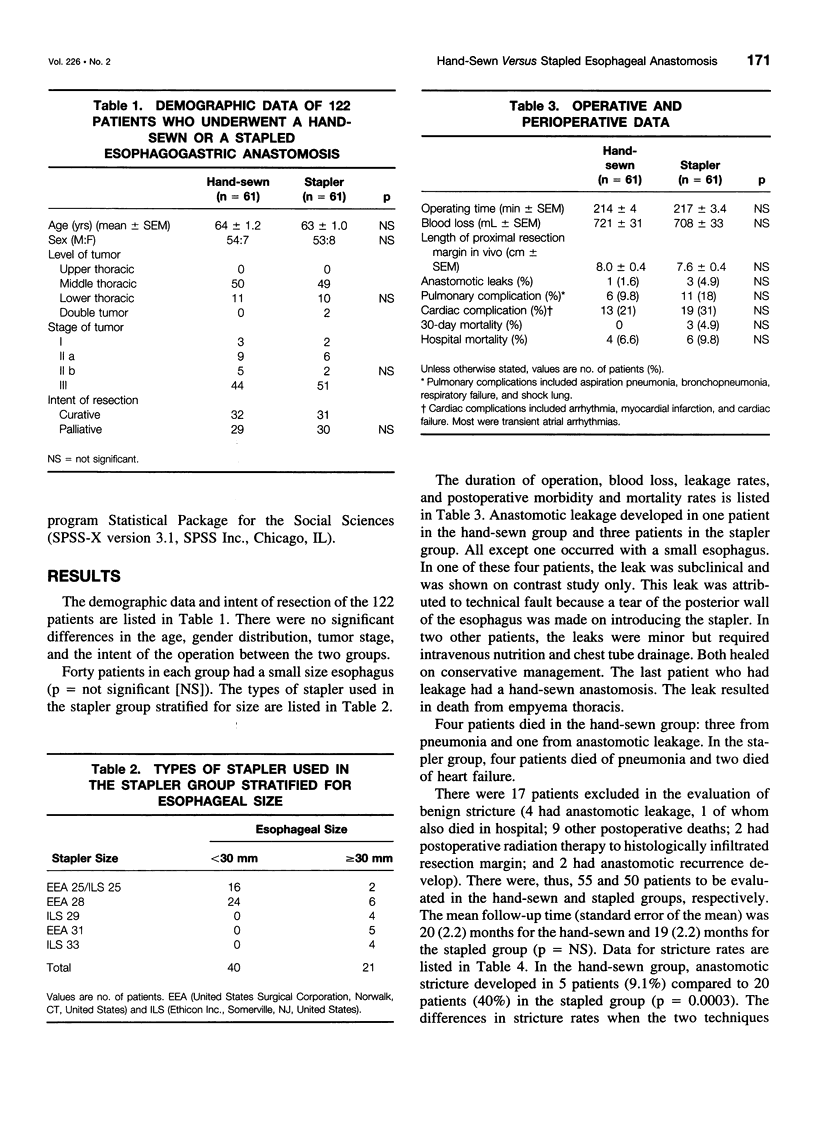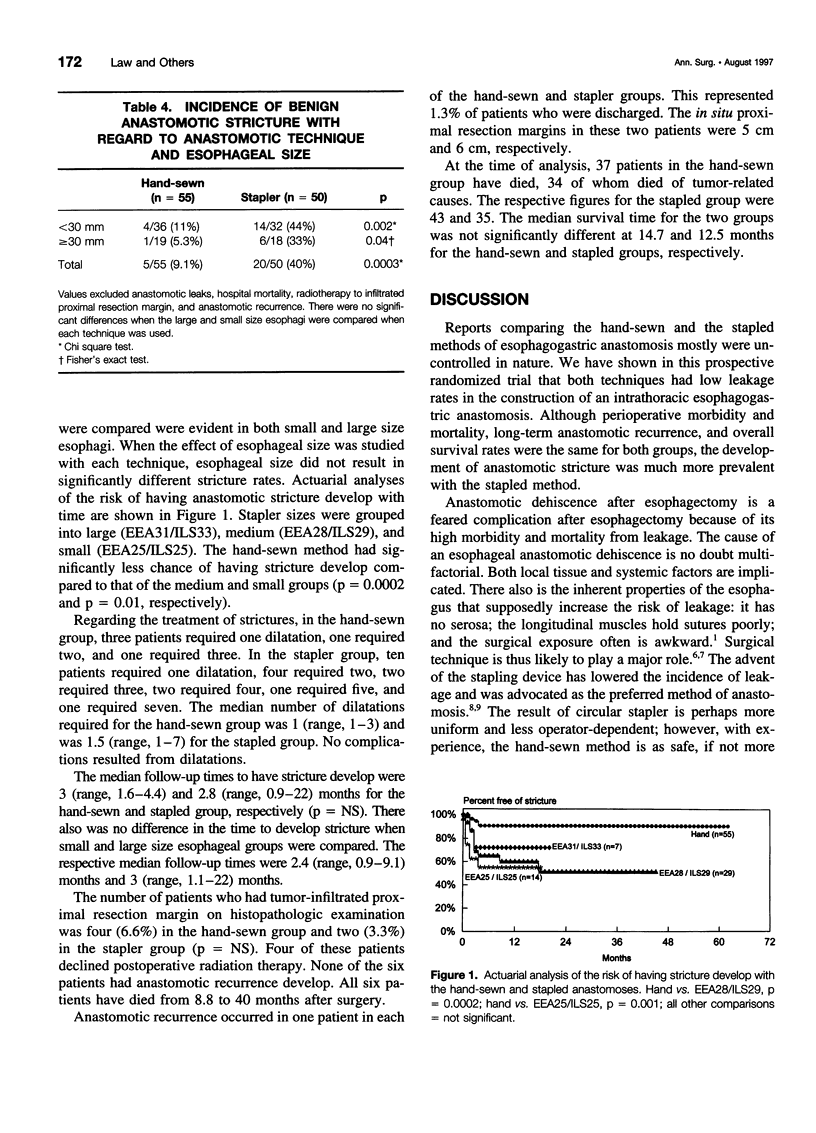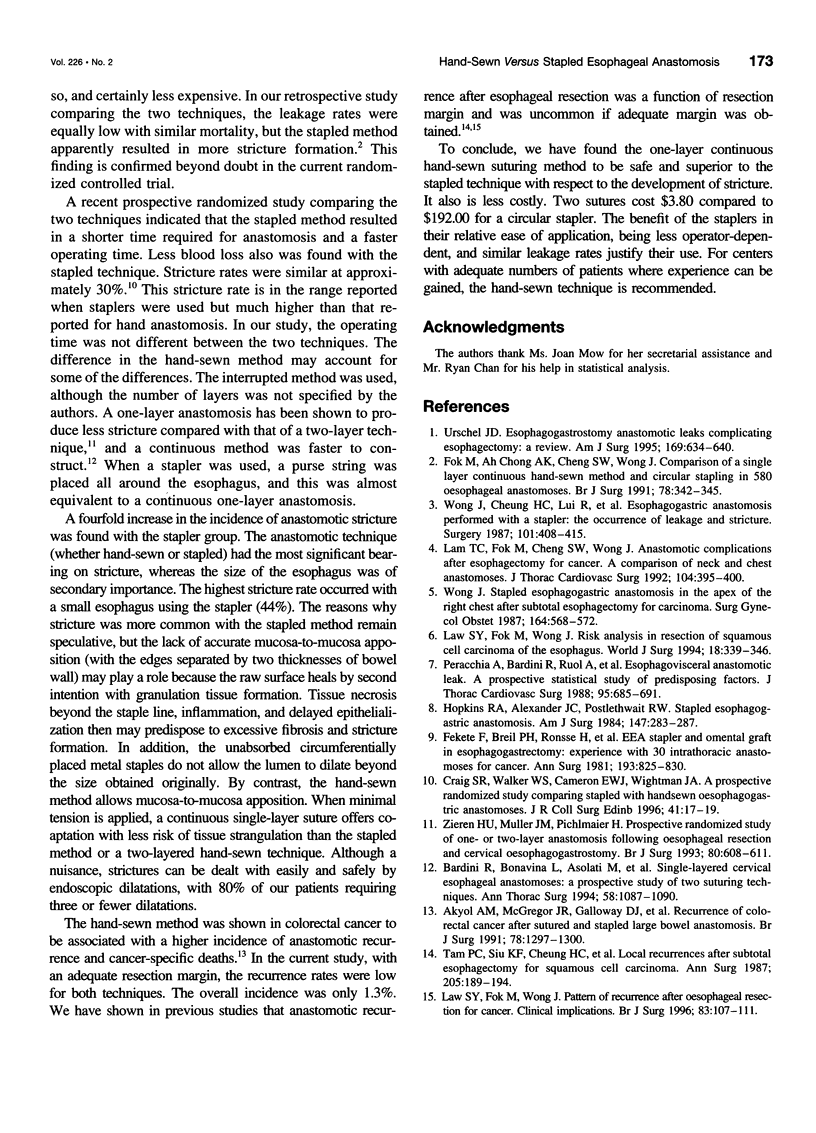Abstract
OBJECTIVE: The objective of this study was to compare the hand-sewn and stapled methods in esophagogastric anastomosis. SUMMARY BACKGROUND DATA: After esophageal resection for cancer, the relative merits of the hand-sewn and the stapled methods of esophagogastric anastomosis, especially regarding leakage and stricture rates, have not adequately been studied. METHODS: A prospective randomized controlled trial was undertaken in 122 patients with squamous cell cancer of the thoracic esophagus who underwent a Lewis-Tanner esophagectomy. Patients were stratified according to esophageal size, based on the diameter of the divided esophagus (< or > or = 30 mm) and then were randomized to have either a hand-sewn or a stapled anastomosis. RESULTS: The mean total operating times (standard error of the mean) when the hand-sewn and the stapled methods were used were 214 (4) minutes and 217 (3.4) minutes, respectively (p = not significant [NS]). The respective in vivo proximal resection margins (standard error of the mean) were 8 (0.4) cm and 7.6 (0.4) cm (p = NS). Leakage rates were 1.6% and 4.9% (p = NS). Excluding hospital deaths, patients with leakage or anastomotic recurrence, and those who received radiation therapy to histologically infiltrated resection margin, anastomotic stricture was found in 5 (9.1%) of 55 patients in the hand-sewn group and 20 (40%) of 50 in the stapler group (p = 0.0003). The difference in stricture rates was significant in small as well as large esophagi. Anastomotic recurrence developed in only one patient in each group. CONCLUSIONS: The authors conclude that both methods were safe, but the stapled technique resulted in more stricture formation.
Full text
PDF




Selected References
These references are in PubMed. This may not be the complete list of references from this article.
- Akyol A. M., McGregor J. R., Galloway D. J., Murray G., George W. D. Recurrence of colorectal cancer after sutured and stapled large bowel anastomoses. Br J Surg. 1991 Nov;78(11):1297–1300. doi: 10.1002/bjs.1800781107. [DOI] [PubMed] [Google Scholar]
- Bardini R., Bonavina L., Asolati M., Ruol A., Castoro C., Tiso E. Single-layered cervical esophageal anastomoses: a prospective study of two suturing techniques. Ann Thorac Surg. 1994 Oct;58(4):1087–1090. doi: 10.1016/0003-4975(94)90461-8. [DOI] [PubMed] [Google Scholar]
- Craig S. R., Walker W. S., Cameron E. W., Wightman A. J. A prospective randomized study comparing stapled with handsewn oesophagogastric anastomoses. J R Coll Surg Edinb. 1996 Feb;41(1):17–19. [PubMed] [Google Scholar]
- Fekete F., Breil P., Ronsse H., Tossen J. C., Langonnet F. EEA stapler and omental graft in esophagogastrectomy: experience with 30 intrathoracic anastomoses for cancer. Ann Surg. 1981 Jun;193(6):825–830. doi: 10.1097/00000658-198106000-00019. [DOI] [PMC free article] [PubMed] [Google Scholar]
- Fok M., Ah-Chong A. K., Cheng S. W., Wong J. Comparison of a single layer continuous hand-sewn method and circular stapling in 580 oesophageal anastomoses. Br J Surg. 1991 Mar;78(3):342–345. doi: 10.1002/bjs.1800780323. [DOI] [PubMed] [Google Scholar]
- Hopkins R. A., Alexander J. C., Postlethwait R. W. Stapled esophagogastric anastomosis. Am J Surg. 1984 Feb;147(2):283–287. doi: 10.1016/0002-9610(84)90108-9. [DOI] [PubMed] [Google Scholar]
- Lam T. C., Fok M., Cheng S. W., Wong J. Anastomotic complications after esophagectomy for cancer. A comparison of neck and chest anastomoses. J Thorac Cardiovasc Surg. 1992 Aug;104(2):395–400. [PubMed] [Google Scholar]
- Law S. Y., Fok M., Wong J. Pattern of recurrence after oesophageal resection for cancer: clinical implications. Br J Surg. 1996 Jan;83(1):107–111. doi: 10.1002/bjs.1800830134. [DOI] [PubMed] [Google Scholar]
- Law S. Y., Fok M., Wong J. Risk analysis in resection of squamous cell carcinoma of the esophagus. World J Surg. 1994 May-Jun;18(3):339–346. doi: 10.1007/BF00316812. [DOI] [PubMed] [Google Scholar]
- Peracchia A., Bardini R., Ruol A., Asolati M., Scibetta D. Esophagovisceral anastomotic leak. A prospective statistical study of predisposing factors. J Thorac Cardiovasc Surg. 1988 Apr;95(4):685–691. [PubMed] [Google Scholar]
- Tam P. C., Siu K. F., Cheung H. C., Ma L., Wong J. Local recurrences after subtotal esophagectomy for squamous cell carcinoma. Ann Surg. 1987 Feb;205(2):189–194. doi: 10.1097/00000658-198702000-00014. [DOI] [PMC free article] [PubMed] [Google Scholar]
- Urschel J. D. Esophagogastrostomy anastomotic leaks complicating esophagectomy: a review. Am J Surg. 1995 Jun;169(6):634–640. doi: 10.1016/s0002-9610(99)80238-4. [DOI] [PubMed] [Google Scholar]
- Wong J., Cheung H., Lui R., Fan Y. W., Smith A., Siu K. F. Esophagogastric anastomosis performed with a stapler: the occurrence of leakage and stricture. Surgery. 1987 Apr;101(4):408–415. [PubMed] [Google Scholar]
- Wong J. Stapled esophagogastric anastomosis in the apex of the right chest after subtotal esophagectomy for carcinoma. Surg Gynecol Obstet. 1987 Jun;164(6):568–572. [PubMed] [Google Scholar]
- Zieren H. U., Müller J. M., Pichlmaier H. Prospective randomized study of one- or two-layer anastomosis following oesophageal resection and cervical oesophagogastrostomy. Br J Surg. 1993 May;80(5):608–611. doi: 10.1002/bjs.1800800519. [DOI] [PubMed] [Google Scholar]


